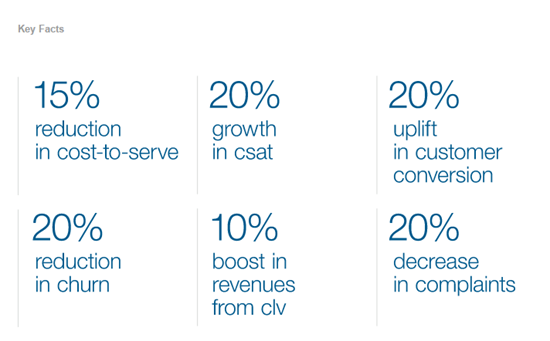Capgemini & inQuba Partners to Deliver Seamless CX via CJA
Capgemini, one of the world's largest consulting, technology, and outsourcing companies, announced that they signed a formal strategic partnership agreement with inQuba, a global innovator in Customer Experience (CX) orchestration software. This will allow, Capgemini's Global Financial Services Strategic Business Unit to jointly market, sell and deliver digital customer experience (DCX) solutions for the insurance industry.
 Paul Cole, President at inQuba Americas, notes: "As the insurance industry becomes more and more susceptible to digital disruption, opportunities will emerge for progressive carriers to move their focus from 'insurance protection to risk prevention,' paving the way for a more interactive and value-added relationship with policyholders. inQuba and Capgemini are organized to provide services within the Insurance Connect framework. inQuba provides the detailed mapping and management of the policyholder, and broker journey enabled by advanced analytics. The inclusion of inQuba's CX3 capability in Insurance Connect represents a first for the insurance industry."
Paul Cole, President at inQuba Americas, notes: "As the insurance industry becomes more and more susceptible to digital disruption, opportunities will emerge for progressive carriers to move their focus from 'insurance protection to risk prevention,' paving the way for a more interactive and value-added relationship with policyholders. inQuba and Capgemini are organized to provide services within the Insurance Connect framework. inQuba provides the detailed mapping and management of the policyholder, and broker journey enabled by advanced analytics. The inclusion of inQuba's CX3 capability in Insurance Connect represents a first for the insurance industry."
The integration will help carriers deliver an 'all channel experience' for their increasingly tech-savvy policyholders as the inQuba solution is focused on the policyholder and broker management layer of the architecture, with its Software as a Service (SaaS) platform. So carriers can understand the key moments of truth with policyholders through event based surveys, and uncover what drives customers through embedded analytics. Through these, they can strategize the most efficient way to engage with customers through customizable communications, retention, up-sell and cross-sell templates. As a result, insurers have the power of an end to end enterprise customer experience orchestration, including voice-of-the-customer analytics and customer engagement functionality. The platform can be either purchased independently or integrated into Capgemini's Insurance Connect ecosystem which is a comprehensive, managed business service hosted by Capgemini on any cloud platform and is pre-configured for specific market segments. Here are some abilities that the platform provides:
-
Migrate legacy manual systems to a best-in-class architecture with minimal risk, lower cost of entry and increased speed-to-market
-
Utilize a library of key interface capabilities to support financials, document generation and management, statistics and reporting, user authentication, and rating.
-
Gain pre-configured, optimized out-of-the-box capabilities that are highly leverageable
-
Focus on your core business functions and leverage world- class IT processing capabilities
Customer Journey Analytics
Customer experience (CX) specialist inQuba has been recognized by Gartner in the recent Market Guide for Customer Journey Analytics report, which offers a guide for enterprises looking to evaluate the various technologies available in the space. So what is customer journey analytics (CJA) for?
The Gartner Market Guide for Customer Journey Analytics (CJA) defines customer journey analytics as the process of tracking and analyzing the way customers use combinations of channels to interact with an organization, and covers all channels, present and future which interface directly with customers. According to the analysts, who cited 20 different vendors in the report, CJA is a nascent, highly fragmented market with many vendors offering partial solutions, so the vendor evaluation process is complex. “Organizations adopting this technology must prioritize functional requirements before selecting a vendor,” the report states.
The report suggests key areas of differentiation between vendors; the channels on which the solutions focus, the manner in which seemingly anonymous interactions are stitched together, the tools in place to provide visualization of journeys, and the outputs to other systems. For instance, customer journey analytics solutions should pull customer profile data from the customer relationship management (CRM) system, which tracks each customer’s relationship and history with a business. A CRM suite stores critical information such as demographics, tenure, lifetime value, preferences, buying behaviors, buying patterns, and so on. This is accomplished by tracking all the interactions, transactions, and activities across all touch points including calls, interactive voice response (IVR), emails, chat sessions, short message service (SMS), social media, as well as the Web self-service, storefronts, live-agent and back-office interactions, follow-up activities, etc
Not only structured data but also unstructured feedback from all customer-facing applications should be incorporated into customer journey analytics. For instance, feedback actively collected from customer surveys, as well as passively collected from social media posts must be addressed by CJA solutions. Customer journey analytics solutions can also help organizations obtain a complete view of how a customer was treated by demonstrating if the organization and agent did what they were supposed to do at each touch point. Combining all of this information and putting it into actionable recommendations helps organizations have a holistic approach to understanding the true voice of the customer (VoC), which is a key stepping stone to customer experience excellence.
Companies that utilize customer journey analytics see a 15-20% reduction in calls and visits, and a decrease in customer churn rate. McKinsey found that journeys are 30-40% more predictive of customer satisfaction as well as churn, and organizations that analyze the customer journey win in customer experience and growth. The consulting firm also laid down the favorable results of implementing CJA solutions:

The Gartner report also sheds a light on how a CJA platform should incorporate throughout four different phases of customer interactions:
-
Gathering: This is the process of gathering data from each of the channels for analysis. According to the report, the challenge of this step is a single sign-on where visitors don’t have to sign into every channel they use.
-
Connecting: CJA applications expect to determine all the possible channels utilized by individual customers as well as the common elements used across those channels.
-
Visualizations: In this stage, CJA applications are tasked to demonstrate the relationship between customer behaviors and channels used throughout the entire customer journey.
-
Acting: Some CJA applications reveal not only meaningful patterns and insights but also provide output in the form of recommendations, cause analysis, and trend charts. This way, organizations can gain a comprehensive view of the data gathered from different channels while assessing the best way to build a life-long relationship with the individual customer.
It’s immersive for organizations to connect the various interactions their customers/prospects make with their businesses to understand their behavior in context, tracking where they are in the journey and what channels they are using along the way, as customer interactions so rarely occur independently from each other. In the coming days, we’ll see more partnerships like this one, between Capgemini and inQuba, in an effort to deliver customer experience excellence. After all, 70% of buying experiences are based on how the customer feels they’re being treated, according to a McKinsey study.

Venus Tamturk
Venus is the Media Reporter for CMS-Connected, with one of her tasks to write thorough articles by creating the most up-to-date and engaging content using B2B digital marketing. She enjoys increasing brand equity and conversion through the strategic use of social media channels and integrated media marketing plans.